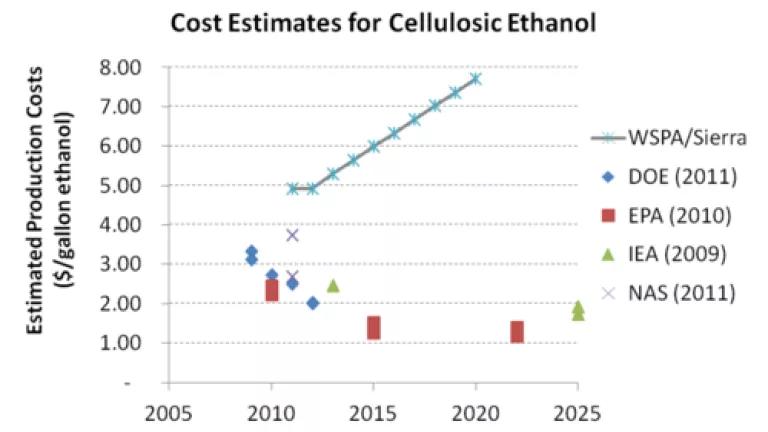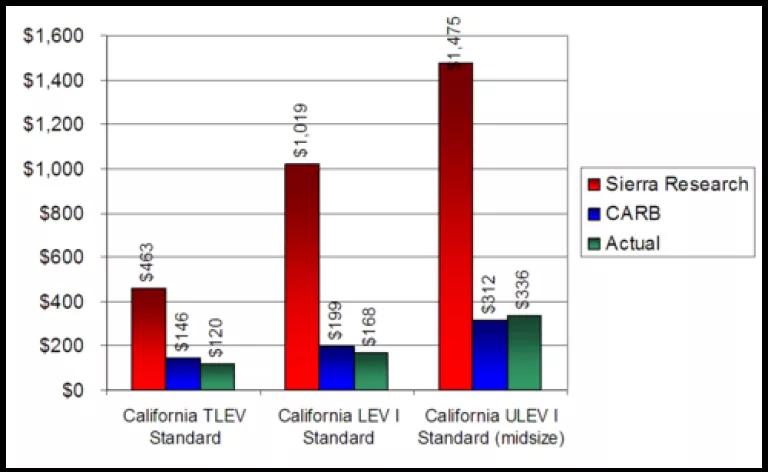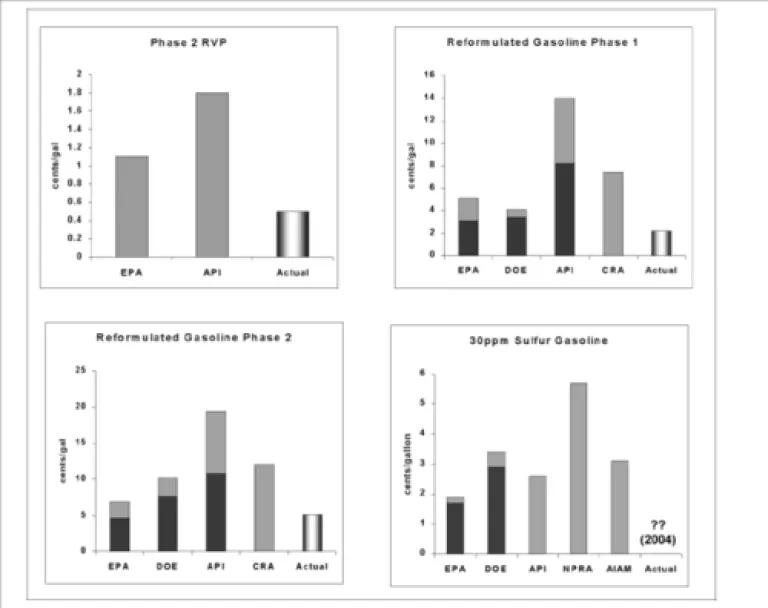
In the latest salvo by the oil industry to weaken California’s low carbon fuel standard, (LCFS) the Western States Petroleum Association released a draft report, authored by an industry consultant, Sierra Research. The report’s exorbitant claims don’t hold up to the estimates in the peer-reviewed literature or any other estimates NRDC is aware of, leaving us simply scratching our heads on this one.
The LCFS, enacted in 2009, requires oil companies to phase in cleaner, alternative fuels to gasoline and diesel over time. Those in the renewable fuels industry, academic community, and government agencies are probably also scratching their heads on where the oil industry came up with its cost numbers.
Below, I show how the oil industry’s estimates stack up against actual estimates from other well-known and peer-reviewed sources such as U.S. Department of Energy, U.S. Environmental Protection Agency, the International Energy Agency, and even the National Academies of Sciences (which has been even criticized for being too high).
The results show that the oil industry (shown below as WSPA/Sierra) utilized frankly nonsensical data coming up with their cost estimates. Higher estimates are one thing, but a straight trend-line that is 7 times more than other estimates by 2020? Really? Unfortunately, similar charts can be shown for the other alternative fuels that were analyzed by WSPA.[1]
It’s no wonder that the oil industry’s “study” results in billions of dollars in costs. In reality, ARB’s earlier assessment utilizing many of the actual referenced studies show that the standards could result in $11 billion in net fuel savings to California consumers and even more at today’s oil prices.
On what data does the oil industry rely that makes its alternative fuels cost estimates so much higher than all the others’?
Apparently, they chose to rely on a single, preliminary draft analysis by the California Energy Commission (CEC) that raised so many eyebrows that it never made it to the final report. Portions of that preliminary analysis were redacted due to errors, and the lead analyst even warning stakeholders – including the oil companies and WSPA present - not to use the cost data for purposes of “Mr. Smith Goes To Washington.” Even so, it has not stopped the oil industry from quoting widely from a signle analysis that even the authors admit was not ready for prime time.
NRDC provided CEC with over forty pages of comments with factual corrections and recommendations for areas to improve, citing methodological errors and the lack of any data or study referenced, as submitted here, here, and here.
It’s Time for the Oil Industry to Sing a New Tune
NRDC is familiar with the oil industry’s past claims and with its funded research that has proven far off from reality. It’s the same ole’ song played over and over again that has failed for years. In fact, retrospective studies published on past cleaner fuel standards have shown that industry groups such as the American Petroleum Institute (API) have overestimated compliance costs –often by several times – versus the actual costs. We show several of these studies below. Sierra Research, funded by Western States Petroleum Association, has a track record that is exceedingly poor, also shown below, when its estimated costs were four to six times too high the last go around.
While it’s no surprise that the oil industry and its member companies are resisting change in their investment patterns and trying to stick with the status quo, they don’t get free reign to provide outlandish numbers without backing up the sources with real, technical cost analysis and primary sources. We should all hold the oil companies and their industry group up to a higher standard than this.
Rather than spending money trying to scare others about alternative fuels, the oil industry needs to start singing another tune and start significantly investing in cleaner fuels. The best way to ensure this happens is to ensure the LCFS doesn’t get weakened.
Past work by Sierra Research on California Low Emission Vehicle Standards.


Source: Todd Sherwood, John F. Anderson, “Comparison of EPA and Other Estimates of Mobile Source Rule Costs To Actual Price Changes.” Society of Automobile Engineers, 2002-01-1980. U.S. EPA.
Notes:
- · IEA (2009) data included both production and distribution costs. These were normalized to other studies showing production costs by removing distribution costs based on EPA (2010) analysis in their Regulatory Impact Analysis for the federal Renewable Fuels Standard program
- · It is unclear whether the preliminary data Sierra Research references from CEC reflects prices, absent description or write-up by the latter. Because it is so high, we have assumed the data is for price (as opposed to it being labeled as cost) and obtained the implicit production costs by removing distribution costs for ethanol as well as operating margins based on historic data produced by Iowa State Center for Agricultural and Rural Development. http://www.card.iastate.edu/research/bio/tools/proj_eth_gm.aspx
Other References:
Catchlight Energy. “Catchlight Energy’s Biomass Liquefaction Process.” US DOE Biomass 2011 Conference.
Antares Group Inc (2008). Strategic Assessment of Bioenergy Development in the West: Bioenergy Conversion Technology Characteristics. Western Governors' Association
DOE, Office of the Biomass Program (OBP), Multi-Year Program Plan, April 2011. OBP, U.S. Department of Energy, Washington, DC, 2011.
IEA (2009), Transport, Energy, and CO2: Moving Toward Sustainability. IEA/OECD.
NAS (2011), Renewable Fuel Standard: Potential Economic and Environmental Effects of US Biofuel Policy. The National Academies Press, Washington, DC.
Parker, N., Tittmann, P., Jenkins, B., 2011. “National Biofuel Supply Analysis.” UC Davis. Western Governors’ Association.
Shapouri, H., Gallagher, P., 2005. USDA’s 2002 Ethanol Cost-of-Production Survey AER-841. USDA, Office of Energy Policy and New Uses.
US EPA [Environmental Protection Agency], 2010. “Renewable Fuel Standard Program (RFS2) Regulatory Impact Analysis,” EPAâ420âRâ10â006, February.
